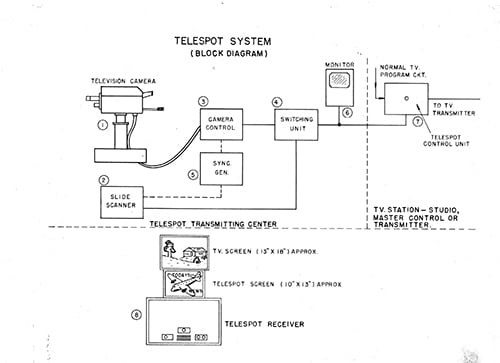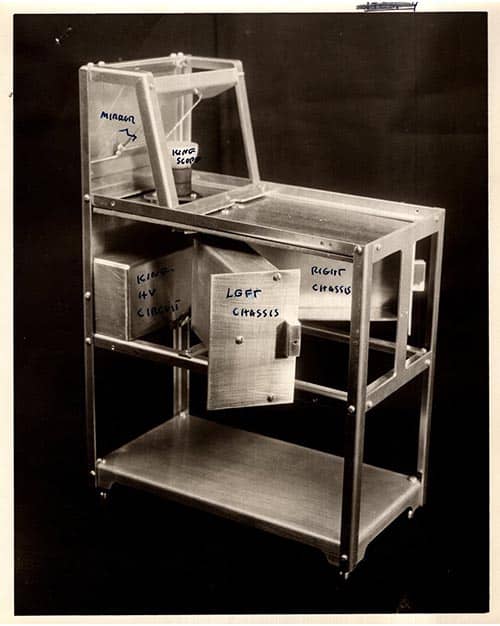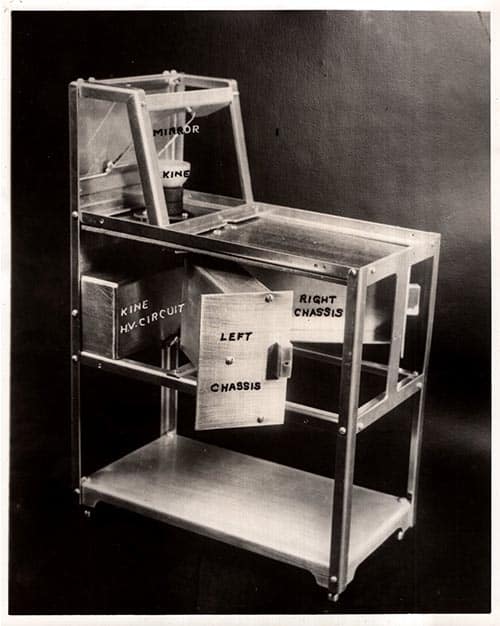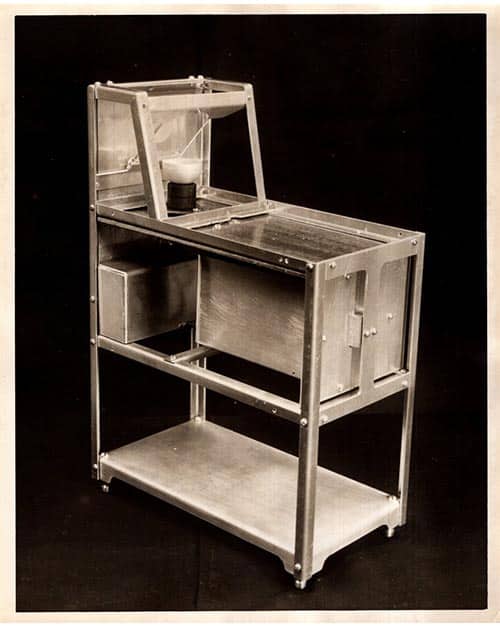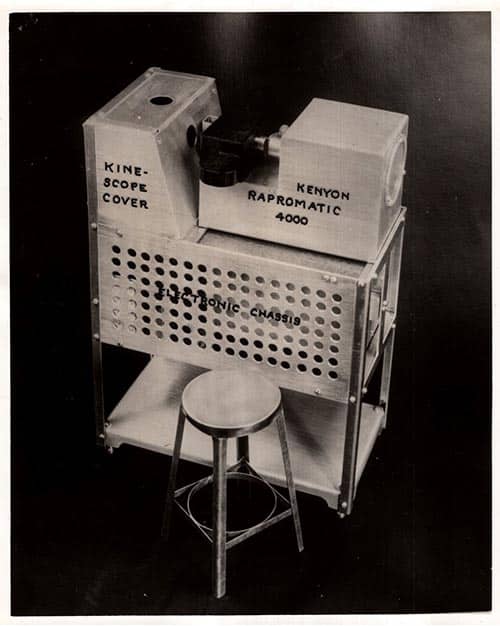The Telespot
The Telespot system was a method of sending information or media (consisting of still photographs, text, and/or graphics) over television broadcasts, which could then be recorded and printed on physical media. The basic concept was that this information could be transmitted in a small fraction of a second (either without interrupting existing programming or broadcast during a station’s off-air hours), virtually imperceptible to the human eye, and would only be able to be reproduced using special equipment and knowledge of the transmission.
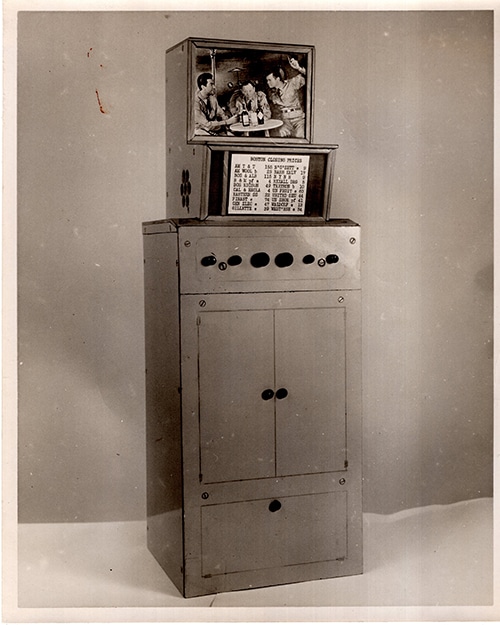
This system had obvious military applications. For example, if sensitive military intelligence needed to be sent rapidly from the battlefield to command headquarters (or vice-versa), the Telespot system made this possible. A map, chart, photo, or a brief document or message could be transmitted over existing TV channels and received at a remote location, processed, and made available to the intended audience in seconds. The data could be sent via radio waves, coaxial cable, or telephone wires, making use of the TV infrastructure that was rapidly expanding during the 1950s when this system was unveiled.

Like most technological developments, the Telespot system was built upon previous ideas. One direct precursor to it was the “Ultrafax” system from the late 1940s, which was a method of rapidly transmitting large amounts of information via the filming and broadcasting of film strips. In one demonstration, the entirety of the novel Gone with the Wind (457,000 words across 1,047 pages) was reproduced via an over-the-air broadcast for the Library of Congress in only 2 minutes and 21 seconds. This system was developed as a joint project between RCA, NBC (which itself originated as an RCA company), and Eastman Kodak. The technology was described as a “radio mail service,” making it an analog ancestor to email.
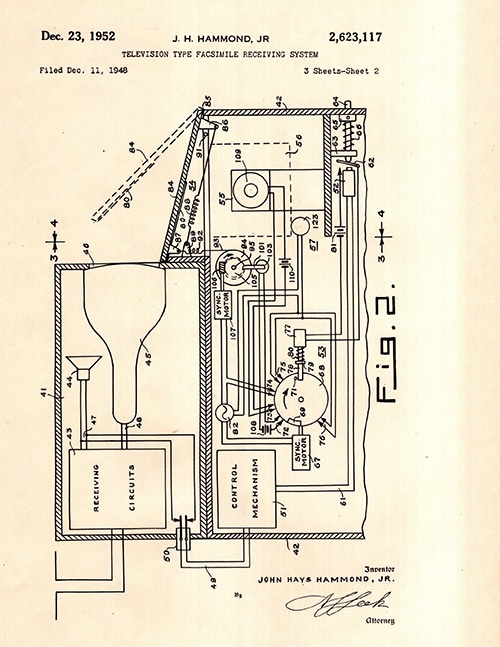
The system was also influenced by teletype technology. These were special electromechanical typewriters that enabled the sending of text-based messages over vast distances in a short period of time. Also known as teleprinters, this technology’s development can be traced back to the 1830s, as part of the telegraph system. Over the course of the 19th century, teletypes became increasingly important for sending and receiving information, and their influence even stretched into the beginning of the information age, when they were adapted into early computer interfaces. Even digital computer terminals that have been in use for decades into the present day are often referred to as “TTY” devices, another term for teletypes.
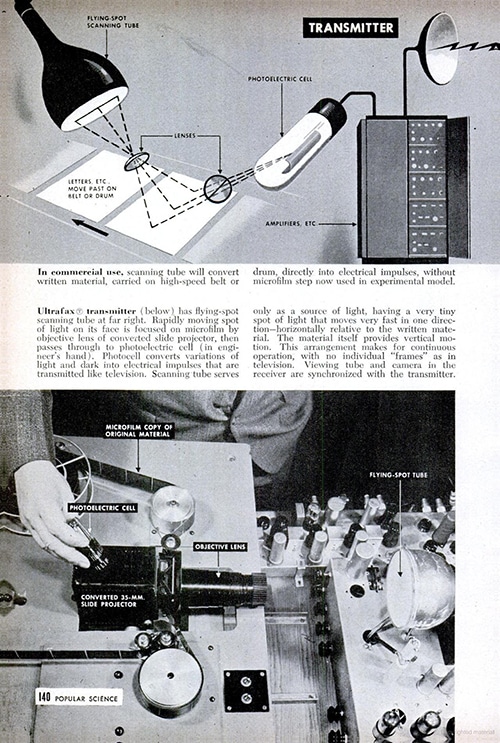
One more important forerunner to the Telespot system was the fax machine. Short for “facsimile,” this technology often associated with the business world of the 1980s and 1990s started life over a century earlier. It evolved from wired to wireless networks over time, and is still in use today in certain industries, particularly in the medical field. The similarity of “fax” and “Ultrafax” is no coincidence.
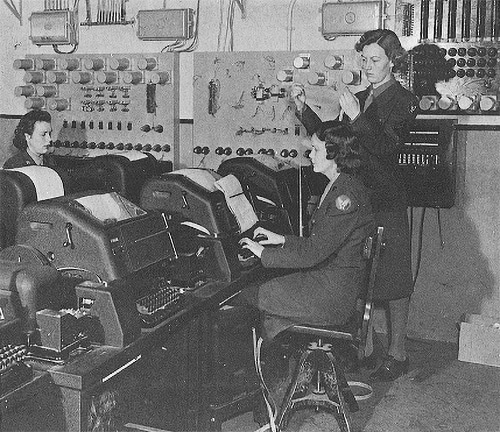
John Hays Hammond Jr. and E. S. Purington (chief engineer at the Hammond Research Laboratory) developed the Telespot system in the early 1950s, although Hammond began researching the underlying technologies for it as early as 1932. Hammond had long recognized the potential of television as far greater than that of radio, for entertainment, commercial, and military purposes. The Telespot system involved the use of a patented dual-screen TV that could display the usual video broadcast on the top screen, alongside a succession of still images that could be stored on film on the bottom screen. One mode of this system would have had the images broadcast repeatedly so as to be clearly seen by the viewer’s naked eye, however the Telespot also allowed for a degree of secrecy.
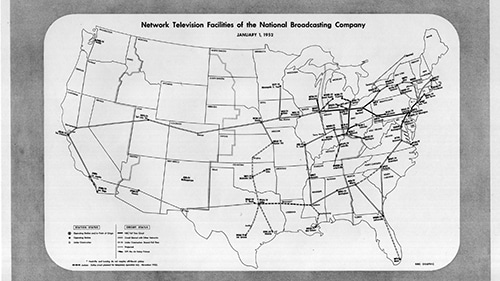
Hammond originally worked on radio encryption methods, and as television was similarly carried along radio waves (as it still can be, albeit with digital transmitters and receivers), it stood to reason that it, too, could be encrypted for security purposes. One of the selling points of the Telespot system was that it was inherently secure (at least by the standards of its time) by virtue of the rapidity of its transmissions – sent and received in less than the blink of an eye – and the special technological requirements necessary to receive, record, and print the contents of the broadcast.
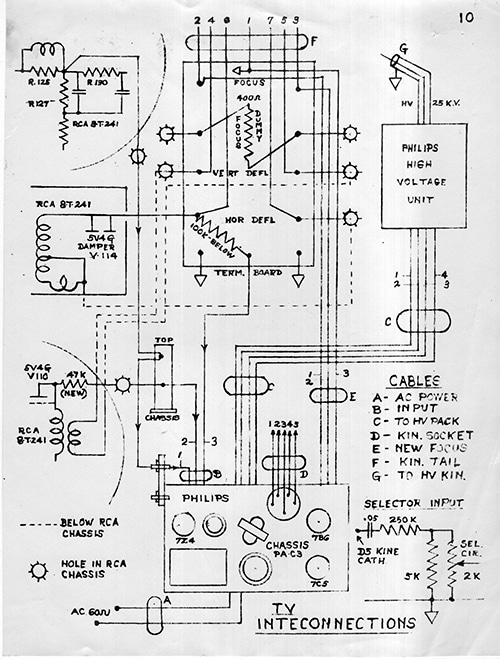
In the case of sensitive data, it was argued that it would have been impractical at best for unauthorized parties to intercept the transmissions, as it required a great deal of expense not only in terms of the necessary equipment, but would also require 24/7 monitoring and filming of the television broadcasts in order to “catch” the Telespot transmission, as the unauthorized party would not have foreknowledge of when it would take place. As this would require a great deal of film, the expenses would be astronomical.
For example, it would have required 26 miles of film to record 24 hours of footage, amounting to about $2500 total for film and processing. In 2025 dollars, that works out to be around $32,000 per day. For a year’s worth of monitoring one station in hopes of receiving Telespot transmissions, the investment an enemy would have to make might well be around $12 million in today’s money when accounting for equipment and labor costs. While not an impossible task, it is understandable why its creators felt the system was unlikely to be breached by an enemy even without encryption methods, at least for some time.
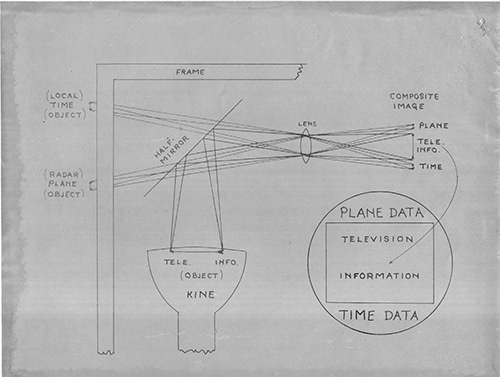
The Telespot was demonstrated for different audiences at multiple times across its development. The legendary President of RCA and founder of NBC, David Sarnoff, was heavily involved in pushing for both the Ultrafax and the Telespot. Hammond was well-acquainted with Mr. Sarnoff through his involvement on the RCA board of directors, a position he obtained in the early 1920s after selling a multitude of valuable patents to them.
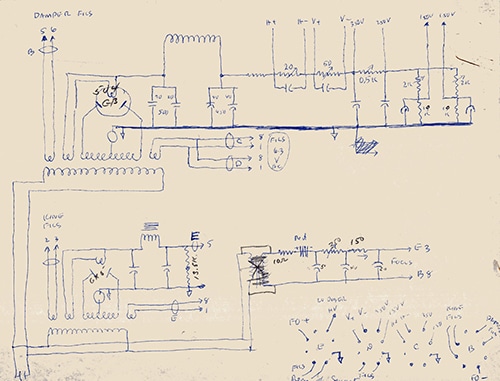
The Telespot was a combination of different technologies. It involved the use of the kinescope, which was both an early name for the cathode ray tube (CRT) as developed by RCA’s Vladimir Zworykin, and a term for the method of using a film camera to record live images off of a television screen, which was the standard way early television programs were recorded prior to the introduction of the videotape.
Through its development, different methods of reproducing the transmissions were considered. Xerography (or photocopying) was in existence at this time, but the technology was in its infancy and impractical for producing high-quality images. Eventually, rapid photo processing was decided upon, with the Rapromatic 4000 utilized in concert with the receiving apparatus. This was a self-contained and portable rapid film processor and projector produced by the Kenyon corporation.
The Rapromatic process was advantageous not only because of its speed, but also because it was a dry chemical method of photo processing that avoided the messy liquids used in other forms of photographic reproduction. Its relatively small size and associated portability meant that it could be used in remote locations as well as on aircraft, which was ideal for its intended use with the Telespot system.
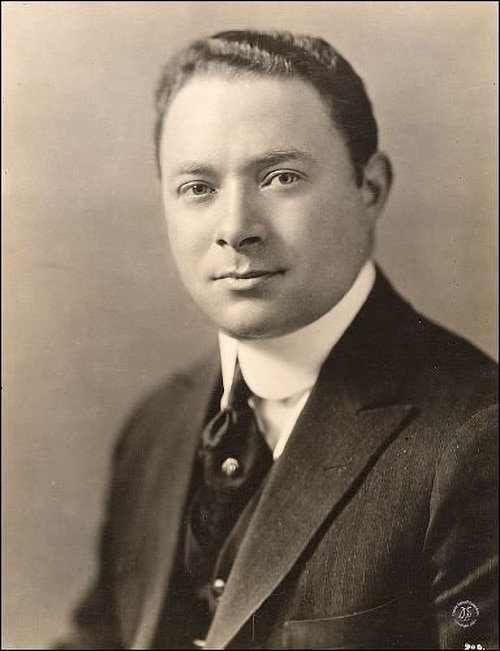
It was proposed that the system could be of use in cases of potential invasion or bombing of the United States, a major concern during the Cold War era. Had it been employed, it would have functioned in a similar capacity to the CONELRAD radio alert system, the Emergency Broadcast System (EBS) that succeeded it, and the current Emergency Alert System (EAS). As Telespot could be used alongside existing TV transmissions, and as it could transmit graphical data instead of just audio, it was superior in some ways to CONELRAD. In all cases, the concept was to alert the public with vital information during an emergency.
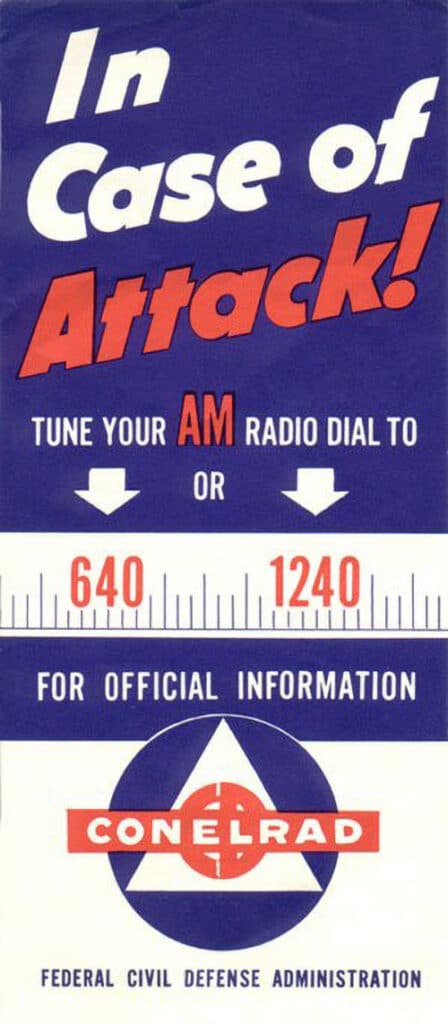
NBC was the dominant television network at the time, as well as the oldest. Its reach made it ideal for carrying Telespot broadcasts over its normal programming, and this was especially important in the case of a national emergency.
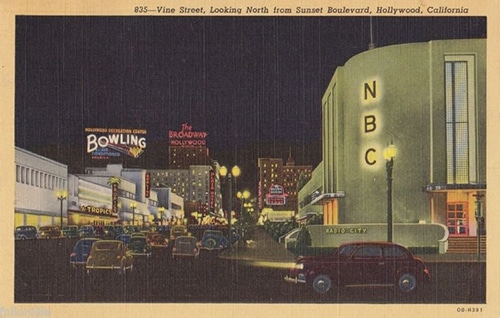
Curiously, some conspiracy-minded commentators have theorized that the Telespot technology was, in part, used to develop “subliminal messaging” programs. To support these spurious claims, Hammond’s apparent interest in spiritualism and psychic phenomena are cited, such as his investigations into whether or not radio waves could affect the human mind, or could act as a conduit for ESP. The research linking these ideas together is questionable, and there is no credible evidence to support the use of the Telespot for any nefarious or subliminal purposes.

In summary, the Telespot system made it possible to transmit small amounts of graphic and textual information over normal television broadcasts over vast distances very rapidly, which could then be recorded at the receiving end and reproduced on physical media for use by the recipient. The system was secure and of value for military and civil emergency purposes, although it could have been used for commercial applications as well.

In essence, the Telespot system was an early link between the “atomic age” and the “information age.” This technology was analog, but had the same motivations and end goals as future digital technology such as computer networks and the Internet. The idea was high-speed data transfer across vast distances in both cases.
